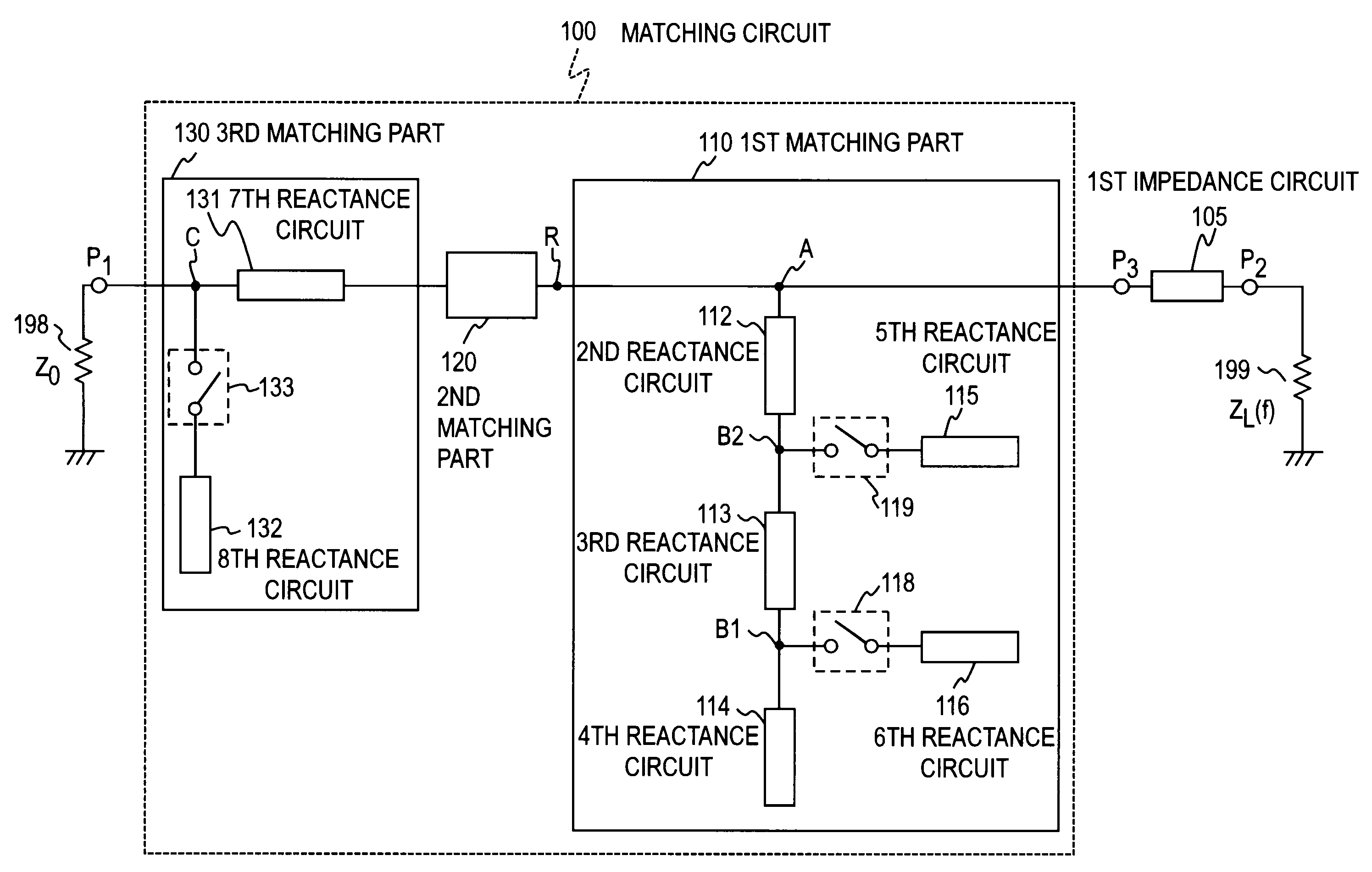Matching circuit
a matching circuit and circuit technology, applied in the field of matching circuits, can solve the problems of large circuitry size, difficult to form a multi-band matching circuit by using circuit elements, and large circuitry volume, and achieve the effect of small design
- Summary
- Abstract
- Description
- Claims
- Application Information
AI Technical Summary
Benefits of technology
Problems solved by technology
Method used
Image
Examples
first embodiment
[0038]FIG. 4 shows a matching circuit 100 according to a first embodiment. The matching circuit 100 shown in FIG. 4 operates as a matching circuit for each of signals in two frequency bands with center frequencies f1 and f2 (f1>f2) shown in FIG. 5. The matching circuit 100 is connected in series between port P1 and port P3. The matching circuit 100 includes a first matching part 110, a second matching part 120, and a third matching part 130, which are connected in series in this order. That is, one end of the first matching part 110 is connected to port P3 to which a first impedance circuit 105 is connected. The other end of the first matching part 110 is connected to one end of the second matching part 120. The other end of the second matching part 120 is connected to one end of the third matching part 130. The other end of the third matching part 130 is connected to port P1.
[0039]The first impedance circuit 105 is provided for changing impedance (changing a resistance component is...
second embodiment
[0074]A matching circuit 200 according to a second embodiment is shown in FIG. 9. Like the matching circuit 100 of the first embodiment, the matching circuit 200 shown in FIG. 9 functions as a matching circuit for each of two frequency bands with center frequencies of f1 and f2 (where F1>f2).
[0075]In the first embodiment, the fifth and sixth reactance circuits 115 and 116 are provided in the first matching part 110 for each of the two frequency bands. Accordingly, the desired matching circuit 100 can be configured in spite of the fact that the second reactance circuit 112 has reactance values that is obtained by a single element or circuit constituting the second reactance circuit 112 in each frequency band.
[0076]On the other hand, in the matching circuit 200 of the second embodiment, the number of components of the first matching part 110 is reduced by designing the second reactance circuit 112 so as to have a predetermined reactance value in a certain frequency band.
[0077]For conv...
third embodiment
[0081]Matching circuits that accomplish impedance matching for each of two frequency bands have been shown in the first and second embodiments. In a third embodiment, a matching circuit that accomplishes impedance matching for each of more than two frequency bands will be shown. FIG. 10 shows a matching circuit 300 according to the third embodiment. The matching circuit 300 according to the third embodiment has a configuration similar to that of the matching circuit 100 of the first embodiment. Therefore, the matching circuit 300 will be described in comparison to the matching circuit 100.
[0082]A first matching part 310 of the matching circuit 300 has a configuration in which the fifth and sixth reactance circuits 115 and 116 of the matching circuit 100 are replaced with a fifth and sixth reactance circuits 315 and 316 that are variable reactance circuits whose reactance values can be changed among q kinds of values (where q is an integer greater than or equal to 2). The variable re...
PUM
 Login to View More
Login to View More Abstract
Description
Claims
Application Information
 Login to View More
Login to View More - R&D
- Intellectual Property
- Life Sciences
- Materials
- Tech Scout
- Unparalleled Data Quality
- Higher Quality Content
- 60% Fewer Hallucinations
Browse by: Latest US Patents, China's latest patents, Technical Efficacy Thesaurus, Application Domain, Technology Topic, Popular Technical Reports.
© 2025 PatSnap. All rights reserved.Legal|Privacy policy|Modern Slavery Act Transparency Statement|Sitemap|About US| Contact US: help@patsnap.com



